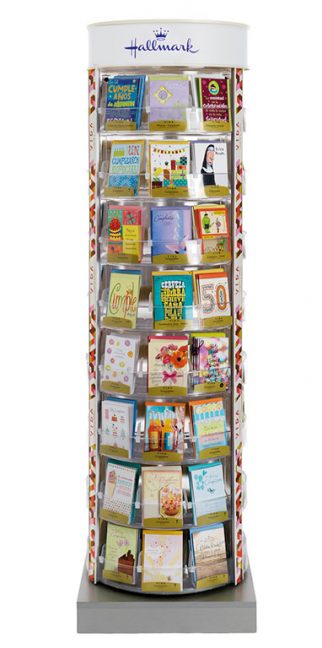by Sara Fernández Cendón/Creative Director-Cultural Identity, Hallmark Cards
Special to The Shelby Report
Why Hispanics are a natural fit for greetings within grocery retail
If you cater to Hispanic customers, you already know the facts: Hispanics are frequent visitors to grocery stores and actually enjoy the experience; they favor fresh foods and home-cooked meals; and they typically don’t shop alone, which means various family members influence purchase decisions during the shopping trip.
What all of the above boils down to is, Hispanics are a deeply social consumer group that is highly engaged in grocery retail. And that is excellent news to product categories that address social needs within the grocery channel—product categories such as greeting cards.
“We started offering greeting cards for the first time last year,” says Mike Hendry, EVP of marketing and merchandising at Northgate González Market, a grocery retailer based in Anaheim, California. “We know our customers expect fresh products from us, and we’ve been working hard to deliver on that promise, but we also know we can deliver value for them in other ways. Now with greeting cards, and with an established partner like Hallmark, we have an opportunity to serve a totally different set of needs for our customers while also building basket size.”
This new set of needs is social, rather than physical or financial, and it is high on the priority list for Hispanic consumers.
Latinos exist within large networks. Connections go far and wide, but they also run deep, which is why the greeting card aisle provides an instant emotional reward for the Hispanic consumer. Our products enhance relationships among people that are by nature very relationship-oriented.
This is in part driven by family dynamics. According to the 2013 American Community Survey conducted by the U.S. Census Bureau, Hispanics have the largest percentage of five-person families among all ethnic and racial groups. Approximately 26 percent of Hispanic families have at least five members, compared to 10 percent of non-Hispanic white families, 14 percent of African-American families and 17 percent of Asian families.
Hispanic families tend to be larger, but when it comes to this consumer, we’re not just talking about the nuclear family.
As one might expect in light of family size statistics, the percentage of women who have had four or more children is higher among Hispanics than among other women. About 20 percent of Hispanic women have had four or more children, compared to 11 percent of white women, 18 percent of African-American women and 10 percent of Asian women. But Hispanic households often are not limited to parents and children living together. According to the most recent Pew Research data, 25 percent of U.S. Hispanics lived in a multigenerational household in 2012, compared to 14 percent of non-Hispanic whites. Although Asians are even more likely than Hispanics to live in a multigenerational household, Hispanics are in constant contact with extended family members, whether or not they share a home.
Grandparents, cousins, aunts and uncles, nieces and nephews—even godparents—are part of celebrations large and small. In many cases, this same cast of characters is just part of daily life, pitching in when help is needed, sharing tips and information, being in touch or just being there.
This means Hispanics have a lot of social bonds to nurture, which is why Hallmark VIDA offers a wide range of cards to meet a wide range of needs and relationships.
We know Hispanics keep friends for life by remembering important occasions, by supporting each other through thick and thin. Hallmark VIDA has a card for every occasion, whether it be another birthday or a quinceañera, a milestone anniversary or a simple “I’m thinking about you.” Hallmark wants to help Latinos stay in touch with the many people they consider close friends and family.
In addition to supporting relationships within a wide social circle, Hallmark’s line of Spanish-language greetings also helps Latinos enhance their closest and dearest relationships. The line offers special everyday greetings for specific relationships and seasonal greetings programs for Valentine’s Day, Easter, Mother’s Day, Father’s Day, Graduation and Christmas.
A typical celebration may involve dozens of relatives and friends and lots of food. We know shoppers come to Hispanic supermarkets to prepare for those kinds of occasions. Greeting cards are a natural extension of what these retailers already offer this consumer to enhance those celebrations.
In addition to Northgate González Markets, Hallmark’s Southern California partner, Navigator Sales and Marketing, has helped to expand the category to Vallarta Supermarkets in San Fernando, California; Big Saver in Vernon, California; Guadalajara Markets; Cardenas in Murietta, California; and Phoenix-based Los Altos Ranch Markets. Each of these retailers has started offering Hallmark VIDA greeting cards this year.
This kind of growth is not surprising, especially considering that this is a young demographic, with more than 60 percent of U.S. Hispanics being under the age of 35, according to Nielsen data.
A low median age—28 compared to 42 for non-Hispanic whites—means that Hispanics are in their peak purchasing years. This group is experiencing the most important life events, like weddings and childbirth. They’re raising families. That’s when this consumer comes to our product category, and that’s when our products mean the most to people.
As to why greeting cards in Spanish are important, according to recent Nielsen data, 37 percent of U.S. Hispanics are culturally Hispanic, and an additional 44 percent of them are bicultural. This means that Spanish plays an important role in the lives of more than 80 percent of U.S. Latinos.
No matter what language they speak every day, Hispanics experience emotions most powerfully in Spanish. More importantly, Spanish helps Latinos stay connected to their roots and pass traditions on to the next generation. It’s an important connecting tool, and Hallmark VIDA uses it to help Latinos feel more at home.
*Editor’s note: This is part of The Hispanic/Asian Marketplace feature that appears in the September print editions of The Shelby Report.






